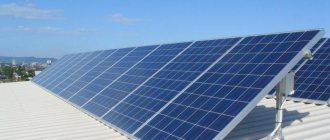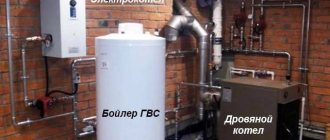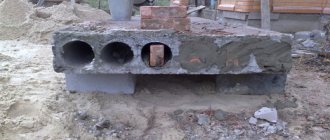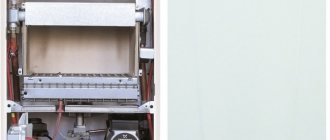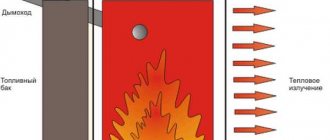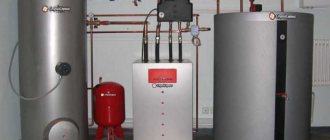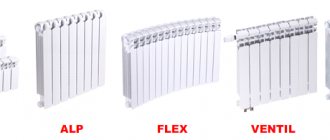Heating a private house with gas cylinders is a necessary measure in the absence of a main gas pipeline. This heating method is often chosen for country houses and dachas with an area of up to 70-100 sq.m. In order to save gas, the building is insulated as much as possible, and a gas boiler is used in conjunction with electrical appliances, if electricity is connected.
The fuel used is liquefied propane gas or mixtures (propane + butane), depending on the season. After processing natural gas under high pressure, it changes from a gaseous state to a liquid state and is pumped into cylinders. Liquefied hydrocarbon gases in the abbreviated version are called LPG.
For heating with LPG, cylinders with a capacity of 50 liters are used (gas weight in liquid state is up to 22 kg). The cylinders are filled to 80% of the volume, because... gas is capable of expanding with increasing temperature and can rupture the cylinder. Also, when the contents of the cylinder are exhausted, complete emptying is not allowed, but only 90%.
What you need to connect
To install a heating system on gas cylinders you will need:
- Gas boiler equipped with a burner for liquefied gas;
- Gas cylinders with a capacity of 50 l;
- Gearboxes;
- Ramp, if several cylinders are connected;
- Shut-off valves;
- Gas pipeline in the form of pipes and hoses for connecting equipment to the system.
Equipment for heating a private house with gas cylinders
When choosing a gas boiler, you should pay attention to models with the lowest operating pressure and high efficiency. Many boiler models are already equipped to work with natural and liquefied gas. If a connection to the main gas pipeline is not expected, then it is better to choose just such a boiler to operate on LPG.
Otherwise, additional equipment is purchased: nozzles for the burner or an entire burner for liquefied gas, and in some models, a gas valve. The natural gas boiler burner is designed for lower pressure in the system and has a valve with a large hole, which can lead to an emergency.
Types of gas boilers
The wall-mounted version is more compact, but less powerful
Types of wall-mounted boilers for home heating
First of all, it is worth dividing gas heating equipment according to functionality: will it be used only for heating or also for preparing hot water for technical needs. If you plan to heat water, you need a double-circuit boiler; a single-circuit boiler only works for heating.
Wall-mounted gas boilers - a small cabinet that is fashionable to install in the kitchen
Next, you need to decide on the type of smoke exhaust. There are gas boilers with atmospheric chimneys and open combustion chambers, and there are those with turbocharged boilers (their combustion chamber is closed). Atmospheric ones require a good chimney and draft in it, oxygen for combustion comes from the room in which the unit is installed, therefore there must be an air flow channel and a working chimney (all this is checked when starting the system).
Types of combustion chambers
Boilers with forced draft (turbocharged) can be installed without a chimney. The boiler's smoke output through a coaxial pipe (also called a pipe in a pipe) can be discharged directly into the wall. In this case, smoke comes out through one pipe (pumped by the turbine), and combustion air enters through the second pipe directly into the combustion chamber.
This type of equipment is good for everyone, except that in winter the coaxial line becomes overgrown with frost, which impairs traction. If the draft is poor, the automatic system extinguishes the boiler so that combustion products do not enter the room. Switching on is possible only when traction is restored, that is, snow build-ups will have to be chipped or otherwise removed.
There is also a separate type of boilers - condensing boilers. They are characterized by very high efficiency due to the fact that heat is removed from the flue gases (vapors condense). But high efficiency is achieved only when operating in low-temperature mode - the coolant in the return pipeline should not have a temperature above +40°C. If the temperature is even lower, even better.
Condensing boilers are the most efficient
Such conditions are suitable for heating with water heated floors. So if you are planning such a gas heating of a private house - with heated floors, then a condensing boiler is what is required. It has few disadvantages - high price (compared to conventional ones) and caustic condensate, which places special demands on the quality of the chimney (made of good stainless steel).
Floor standing gas boilers
If you need more power, the wall-mounted option will not work - they have a maximum output of 40-50 kW. In this case, a floor-standing boiler is installed. Here they are of high power, and there are also models that can work in cascade. This way you can generally heat large areas.
Some of the floor-standing boilers can operate not only from main gas, but also from liquefied gas. Some can also work with liquid fuel. So these are quite convenient units. Their body is made of steel, and the heat exchanger can be steel or cast iron. Cast iron ones weigh and cost more, but have a longer service life - 10-15 years. Inside the housing there is a burner, automation and heat exchanger.
The structure of a floor-standing gas boiler
When choosing, you need to pay attention to the functionality of the automation. In addition to the standard set - monitoring the presence of gas, flame and draft, there are many more useful functions:
- maintaining the set temperature,
- possibility of programming modes by day or hour,
- compatible with room thermostats;
- adjusting the boiler operation to the weather,
- summer mode - work to heat water without heating;
- possibility of working in parallel with solar panels or other alternative heat sources, etc.
The wider the functionality of the automation, the more expensive the boiler and its maintenance
But many programs also allow you to save fuel, which is no less important. In general, the choice is yours.
Connection diagram to the boiler
The cylinders are connected to the system through a special reducer, which converts the gas from liquid to gaseous for further supply to the boiler.
Gas cylinders with separate reducers
Note! The gas flow rate through the reducer should be 1.8-2.0 cubic meters per hour; a conventional gas reducer with a flow rate of 0.8 cubic meters per hour is not suitable for this system.
When connecting cylinders to the boiler, two options are used: one common reducer for all cylinders or a separate reducer for each. The latter option is safer, but also more expensive.
Several cylinders can be connected to a gas boiler at once, which allows you to increase the time between their refills. For this, a ramp is used - a two-arm manifold that distributes the cylinder capacities into two groups, the main and reserve.
First, gas is selected from the cylinders of the main group, and when it runs out, the ramp automatically switches the boiler to the reserve group. The moment of switching is accompanied by a signal. After connecting already filled cylinders to the ramp, the boiler automatically switches to operation from the main group.
Connection diagram of cylinders to the ramp
Note! Gas cylinders are installed at a distance of at least 2 m from the boiler, but the optimal option for their placement is in a separate non-residential premises or an insulated gas cabinet on the north side of the house.
Do not expose gas cylinders to direct sunlight.
The wall thickness of metal gas pipeline pipes must be at least 2 mm. Where it passes through the walls, the pipe is placed in a special case and foamed. The boiler is connected to the gas pipeline using a flexible connection, and a rubber-fabric hose (durite hose) is used for the reducer.
Liquefied gas consumption
To understand how efficient and expedient it is to heat a house using LPG, let’s calculate the consumption of bottled gas for a house with an area of 100 sq.m. In such a house, according to thermal calculations, it is recommended to install a 10 kW boiler. To produce 1 kW of heat, the boiler consumes an average of 0.12 kg/hour of gas. Gas consumption for heating the entire area will be 1.2 kg/hour, and per day - 28.8 kg. If we consider that a standard 50 liter cylinder contains about 22 kg of gas, then the weekly consumption will be about 9 cylinders, and this is absolutely impractical.
Gas cylinders with a volume of 50 liters
But in this mode, the boiler only works to heat up the heating system. The rest of the time, a properly adjusted boiler consumes 3-4 times less gas, i.e. about 8-9 kg of gas per day or approximately half a cylinder. per week to heat a well-insulated house of 100 square meters. m will need about 3 gas cylinders. In this case, the temperature inside the room will be maintained at +22 degrees (at -18-20 degrees outside).
Heating efficiency can be increased through the use of automation.
Note! A decrease in temperature at night by 6-7 degrees leads to a reduction in gas consumption by 25-30%.
This means that per week, to provide such a system with liquefied gas, you will need about 2 cylinders.
In the case of heating a country house, during the absence of the owners, you can set the temperature to +5+7 degrees (only to maintain the heating system in working condition). Then the gas consumption per week will decrease to 1 cylinder.
When increasing the heating area, the required number of cylinders is calculated in proportion.
Gas cylinders in winter
If gas cylinders are located outside the house, then in winter at subzero temperatures the pressure of liquefied gas decreases and the boiler may simply turn off. To prevent this from happening, the cylinders are installed in a special cabinet with good ventilation, insulated with non-flammable materials. Also suitable for this purpose are detached non-residential buildings with minimal heating. When using cylinders, safety precautions should be observed:
Special cabinet for installing cylinders
- It is prohibited to heat containers with gas using open fire;
- There should not be a basement or cellar near the cylinders, since liquefied gas sinks down when leaking, has no odor and can accumulate to an explosive concentration;
- It is advisable to install a gas leak sensor;
- Storage of full containers is allowed at a distance of 10 m from the living space;
- Storing empty cylinders in the house is prohibited;
- Once every 4 years, it is necessary to check the cylinders for integrity and tightness.
Gas heating options
While reading the article, you probably noticed references to liquefied and main gases. A reasonable question arises: how do they differ? Is it more profitable to heat a private house using a main line or cylinders? Let's figure it out now.
Types of gas heating:
- Mainline. The most environmentally friendly. It consists primarily of methane, which is purified from various impurities, leaving a tiny amount of odorant that allows people to detect gas leaks. However, installing it is not without headaches. You will need to coordinate documents with official authorities, you will need to worry about sufficient pressure in the pipes, and the wiring itself is a rather complicated undertaking.
- Liquefied. The same gas in bright red cylinders in which the familiar propane-butane mixture is stored. But they will not interfere if you install an underground tank in which the cylinders can be safely stored. It needs to be replenished once or twice a year. Suitable for any boilers.
As you can see, liquefied gas is more profitable than main gas, but it is important to remember that about 50 liters of gas fit into one cylinder. One such cylinder is changed every two to three days.
While the main one flows through pipes to your apartments. And gas tanks, in which gas is stored in cylinders, are filled with a special machine. This fact is taken into account in winter. The storage area must be cleared of snow.
Disadvantages of heating with liquefied gas
The main disadvantages of a heating system using gas cylinders:
- The inconvenience of periodically refilling cylinders, especially in the case of self-refueling (there is no delivery of cylinders to your home);
- The imperfection of the method of determining the fullness of the cylinder - by weighing;
- High gas consumption with an incorrectly adjusted system and, accordingly, a decrease in its efficiency;
- It is not always possible to create the necessary conditions for installing cylinders - stopping the boiler at low temperatures;
Gas cylinder refilling device
What cylinders are needed for heating
When installing heating systems in private or country houses, it is preferable to use cylinders with a volume of 50 liters. To fill them, a special mixture of butane and propane is used, which, when exposed to high pressure, is in a liquid state. In addition, to heat your home, you can actively use the following fuel combinations:
- SPBTL. It is a technical mixture consisting of propane and butane. Used for heating rooms in spring and summer.
- SPBT3. It is a technical mixture that consists of gases such as propane and butane. It is used for heating systems mainly in winter.
It is necessary to monitor the condition of the cylinders especially carefully in the winter season. After all, even at sub-zero temperatures, gas does not freeze. However, in this case, there is a high risk of stopping the supply of fuel to the heating system. The boiling point of gases such as propane and butane differs from each other. Propane boils at -40 degrees Celsius, and butane at 0 degrees Celsius.
Cylinders used to store gas must be painted a certain color (orange or red). They also need to be specially marked with the date of completion and serial number. It is prohibited to use basements or ground floors of houses to store cylinders.
In what case can such a system be used?
This heating method is often chosen if electricity is not supplied to the house, but in the future it is planned to connect to the main gas pipeline. Then there is no need to buy two boilers, and buying a gas boiler will justify itself - it will only be enough to switch it from operating on liquefied gas to normal mode. Sometimes liquefied gas boilers are used simultaneously with electrical equipment or a heated floor system in order to save money.
When choosing a heating system using LPG, the area of the house and the degree of its thermal insulation must be taken into account. The optimal heating area with such a system is up to 100-150 square meters. m, and houses with high-quality thermal insulation and no cracks. Heating of areas over 150-200 sq. m is already becoming inefficient and requires regular refilling of too many gas cylinders.
